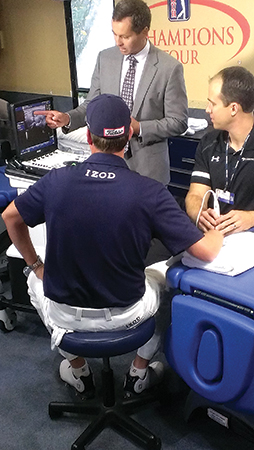Until last week, PGA Tour golfers had to visit a doctor’s office to get in-depth information on an injury.
 |
Dr. Tom Hospel shows PGA Tour golfer Webb Simpson how the ultrasound works.
Photo by: MICHAEL SMITH / STAFF
|
But one of the tour’s official marketing partners, General Electric, is placing its ultrasound equipment inside the health and wellness trailers at PGA Tour events, providing players more immediate feedback on what ails them.
Each ultrasound unit sells for $40,000 and the tour has bought two of them from GE Healthcare, one for the PGA Tour and one for the Champions Tour, each of which will be placed in the Visionworks-sponsored health and fitness trailers.
GE’s ultrasound unit, called the Logiq e, comes in the form of a high-tech laptop, so it requires minimal space inside the tight confines of the 900-square-foot health trailer, which is where players work out and stretch under the care of physical therapists. As the ultrasound wand scans a part of the body, an image appears on the laptop screen.
The Logiq e first appeared in the tour’s health trailer at the Wells Fargo Championship in Charlotte last week and will be on-site from now on.
Webb Simpson and Charles Howell III, the two players on tour sponsored by GE, were the first to check it out at the event last week. GE captured video of the two golfers in the health trailer, and that footage will be used on the GE Healthcare website, in videos used for medical conferences, and for other internal purposes.
“We’ve had orthopedic sports medicine coverage on-site in the past, but if there was a need for any kind of imaging test, the player was sent to a physician’s office to do the scan,” said Dr. Tom Hospel, a sports medicine physician and the tour’s medical adviser. “With ultrasound technology, you’re able to see the extent of the injury right then and there.”
GE Healthcare, a $16 billion division, has made ultrasound a focus of its sponsorship activation with other properties, such as the Olympics and the European Tour.
Chris Katsuleres, who oversees Olympic and sports marketing for GE, said sporting venues are often an ideal venue to entertain customers, while also showing them how the ultrasound is used by major properties. Customers would include clinicians, physicians or anyone else who might buy one of these units.
GE’s ultrasound unit is mostly valuable to golfers to diagnose tendon or ligament damage in joints, bone fractures and muscle strains, without radiation. Hospel’s company will collect data from the tests they do and report injury trends back to the tour. Hospel projects about five to six injuries per week on tour that might call for an ultrasound. Wrist injuries were found to be most common on the European Tour.
Bringing ultrasound to PGA Tour venues also further integrates GE into the tour’s day-to-day operations and incorporates the brand’s technology, something the company has been seeking since it became an official marketing partner in 2011.
GE works with IMG Consulting and its vice president, Kirsten Hunt, on its strategy and activation.
GE has offered body composition testing for the players, but that wasn’t considered as core to their health needs as ultrasound.
“This is the fourth year of our partnership with the tour and we’ve been looking for ways we can add value to the players, from a health care standpoint,” Katsuleres said. “As we’ve evolved the relationship and thought about how we can bring in more of our diagnostic technology, that led us to this.”
But bringing ultrasound technology to a sports venue isn’t as simple as placing the machine in the health trailer that travels from tournament to tournament. Someone’s got to read the results, and anyone who’s watched a pregnant mother’s ultrasound knows it’s not as easy as it looks.
Hospel, who became the tour’s medical adviser in 2007 when it began formulating a drug-testing policy, said ultrasound reading can require as many as 150 hours of training.
The ultrasounds at PGA Tour events will be read by trained technicians who work for Hospel’s business, Physiofitness Associates. If further expertise is required, off-site specialists — Dr. Tony Bouffard and his team based in Michigan — will be on call to read images sent real-time over the Internet.




